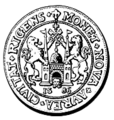Riga coat of arms
|
Riga Republic of Latvia |
|
|---|---|

|
|
| Blazon | |
|
|
| Basic data | |
| Introduction: | 1925/88 |
| Legal basis: | 1656: Right to use the Swedish crown in the coat of arms. 1788: Confirmation by Tsarina Katharin the Great |
| Supporting documents: |
October 31, 1925 February 15, 1967 |
| Changes: | ..., 1925, 1967, 1988 2 |
| swell | |
|
1 translation of www.riga.lv |
|
Riga has a large and a small coat of arms. The city has been running it in its current form since 1988. This is a reintroduction of the coat of arms from 1925.
history
The oldest coats of arms of Riga can be found on the seals from the period 1225–26 and 1330–40. The most important heraldic elements can be found on it, as the coat of arms still contains today. So the opened city gate, which symbolizes the city rights, i.e. the autonomy of the city confirmed in the Middle Ages. Riga was granted city rights in 1201 by Bishop Albert . (The cross staff probably represents his power over the city.) The crossed keys represent the patron saint of the city, Sv. Pēteris , that is, Peter . These are the keys to heaven, as they are described in the Bible: "I want to give you the keys of the kingdom of heaven". In the upper part of the seal was the bishop's scepter, which was replaced by the cross of the Teutonic Order when the city fell under his rule. The lion in the gate, which stands for the defensive strength of the Rigans, was soon added.
In 1554 the lions were added as a new heraldic element as a shield bearer. It is unlikely that these symbolize the dependence on the Kingdom of Sweden , as the city was only conquered by it in 1621. In 1656, the city also acquired the right to depict the crown of the Swedish king, namely as an award for services in the heroic defense of the city during the siege of Riga by the Russians.
At the beginning of the 18th century, however, the city fell to the Russians, in 1710 under Tsarina Catherine II. The Russians changed the stately symbols in the coat of arms - the shield bearers were replaced by the divided double-headed eagle of the Russian coat of arms. It stayed that way into the 20th century. In 1918 Latvia became independent and in 1923 the eagles were replaced by the lions as a sign of this.
In 1925 the changed coat of arms was officially confirmed. In 1940, however, due to the annexation by the Soviet Union , the coat of arms was no longer used in this form, as in the Soviet Union no value was generally placed on city arms. It was not until 1967 that Riga received a coat of arms again, but this was changed compared to the previous version. In the design proposals, the cross of the Teutonic Order was replaced by the red star of the Soviet Union. The founding year 1201 appeared as a number instead of the lion in the gate. The colors of the Latvian flag at the time of the Soviet Union were set below this. However, the design of the coat of arms of this time did not correspond to the strict heraldic rules.
In 1988, prior to the final independence in August 1991, the coat of arms from 1925 was confirmed.
Footnotes
- ↑ International Civic Heraldry: www.ngw.nl ( Memento of the original dated June 10, 2008 in the Internet Archive ) Info: The archive link was inserted automatically and has not yet been checked. Please check the original and archive link according to the instructions and then remove this notice.
- ↑ See: Matthew 16, verse 19
- ↑ Even today the lion is a Swedish national symbol and can be found next to the coat of arms as a carrier. See: Swedish coat of arms around 1600
- ↑ See: Flag of the Latvian SSR
- ↑ The blazon from 1925 describes the coat of arms as follows: Sudraba laukā sarkans ķieģeļu mūris ar diviem torņiem un paceltiem vārtiem, kuros zelta lauvas galva, vairoga augšdaļā starp torņiem zem zelta kroņa zelta ķetnu krusts un divotas sakeln. Vairoga turētāji ir uz stilizētas akanta lapu balstītas pelēkas dzegas stāvoši divi zelta lauvas ar sarkanām mēlēm un atpakaļ grieztu galvu.
- ↑ In contrast to the city's official website, www.ngw.nl ( memento of the original from June 10, 2008 in the Internet Archive ) implies information: The archive link was automatically inserted and not yet checked. Please check the original and archive link according to the instructions and then remove this notice. that Riga only introduced the new coat of arms in 1990 and also that the city did not have its own coat of arms at the time of the Russian occupation.












